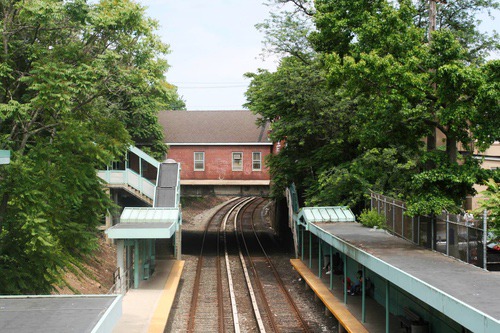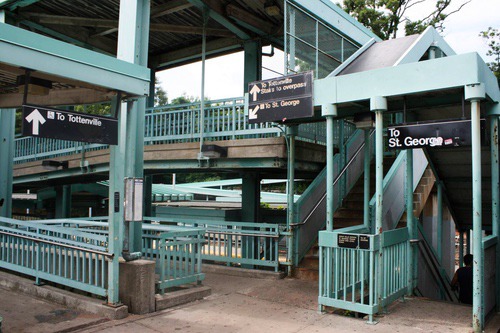


Great Kills is an important Staten Island Railway station, and only transfer point for passengers who want to ride between intermediate stops north of the island to south of the island during rush hours. During both the AM and PM rush hours Tottenville-bound Staten Island Railway trains, timed in conjunction with the Staten Island Ferry arrivals every 15 minutes, operates on a zone-based express system. Here after a ferry arrives in St. George, an express train runs non-stop to Great Kills before a couple of minutes later a local train making all stops leaves St. George running only to Great Kills where it terminates. The extra time this local train takes to reach Great Kills, results in just a 4-minute connection to the next express train that has met the following Staten Island Ferry for passengers wanting to continue south for intermediate trips from Clifton to Arthur Kill for example.
Going the opposite direction, the role of Great Kills as a transfer station are less clear. In the AM rush hour, St-George-bound express trains also stop at Bay Terrace, Oakwood Heights, and New Drop, making all those stations potential transfer points for passengers going between intermediate stations. In the PM rush hour Great Kills isn’t a transfer point because there is no St. George-bound express service. Tottenville expresses return to St. George as local trains making all stops from Tottenville. The local trains to Great Kills, reverse at Great Kills and deadhead back to St. George without any passengers.
The station isn’t that well set up as a place to short-turn trains, there is no extra platform for terminating trains with just two side platforms for the two-track line. Terminating trains have to discharge their passengers before continuing south of the station to the Holly Interlocking and reverse onto the St. George-bound track before changing direction directly on a mainline track. This isn’t much of an issue with SIR frequency at most 2 trains every 15 minutes in both directions (operating quite close together due to the zoned-express operations configuration). There is a tiny siding just south of the station here, but it’s connected in the Tottenville-bound direction to the St. George-bound track.
For passengers, Great Kills was grade-separated between 1930 and 1933. The station is in an open-cut below local streets with trees surrounding each platform. The station has a small brick station house along the west side of Gliffords Lane. Here is a large brick station house with a small waiting room between the two platform entrances that was staffed by a ticket agent until about 1995. Passengers enter each platform via a staircase down to the end of each platform. These staircases lead down to platform canopies painted turquoise. The platform canopy on the Tottenville-bound platform only covers about half a car, while the canopy on the St. George-bound platform extends to the secondary, but accessible entrance built in 1997. There are additional sections of canopy on the Tottenville-bound platform on each side of this entrance.
From each platform. this accessible entrance consists of a covered ramp with a single switchback, and a staircase up from each platform to entrance areas slightly above the platforms. Beyond each of these entrance areas are a short staircase and a continuation of each of the ramps up to a pedestrian bridge with the same canopy and blue railings as the station platform canopies. This overpass connects the two platforms.
The entrance areas on each platform lead to very different surroundings. The St. George platform is at a tiny parking area, alongside Bower Court which is the local shopping district for the Great Kills neighborhood. There ‘railroad suburb vibes’ like those found around so many pre-World War II commuter rail stations.
The Tottenville-bound platform exit leads to a 140 feet long entrance walk between single family home backyards to the corner of Baltimore Street and Rhett Avenue that’s very poorly marked from the street for entering passengers to find. This is probably intentional because local residents don’t want attention drawn to this railway station entrance between their homes.
Photos 1-25: June 20, 2011;

